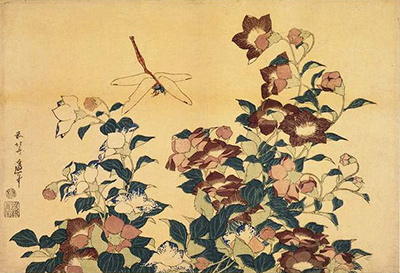Hokusai was a major exponent of bird-and-flower prints, known as kacho-e. Despite the name, these prints can depict not only birds and flowers, but insects, fish, and trees.
One example of this type of work is Bluebells and Dragonflies, created in 1833. During this time the artist was using the name Gakyo-Rojin, which translates as “old man mad about painting.” It is a woodblock print, and one of a series known as Large Flowers. Bluebells and Dragonflies is similar to other works in the series, with the subjects being painted in meticulous detail. The flowers and their leaves cover most of the print, intertwined and extending, towards the top of the work. A breeze appears to be blowing, curling the petals.
A number of the leaves are being turned by the wind, and their pale green undersides can be seen. Hovering amongst this foliage is a dragonfly, about to dive into the flowers below. Dragonflies often appear in Japanese art, they symbolise happiness, strength, and courage. They have a strong association with Japan, being a common sight around paddy fields, especially in the summer months. Particular flowers have various traditional meanings in Japanese culture. The subject of this work, the Bluebell, is a symbol of gratitude.
Katsushika Hokusai was a Japanese artist, born in 1760, in Edo (present-day Tokyo). He was a renowned printmaker and ukiyo-e painter. His output was prodigious; he produced 30,000 pieces of art in his lifetime, completing his final painting a year before his death, in 1849. His most successful pieces were created later in his life, after the age of 60. It was at this time that he produced his most famous work, a series of prints, “Thirty-six views of Mount Fuji.” The first of which was the iconic, The Great Wave off Kanagawa. He changed his name constantly throughout his career, a common practice amongst Japanese artists of the time, using up to 30 different names in total.




